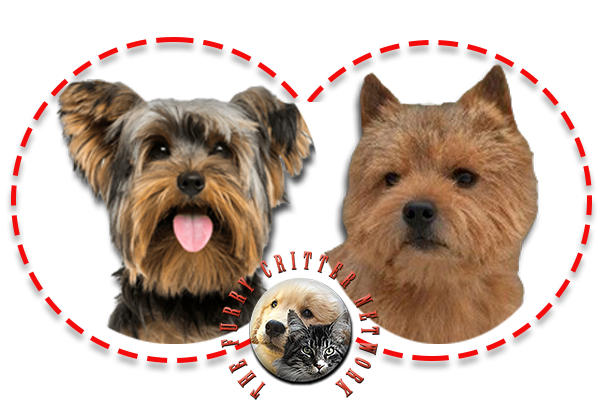Behavior
These small but hardy dogs are typically courageous, intelligent and affectionate. They can be assertive, but it is unusual for them to be aggressive. They are energetic and thrive on an active life. They are known to be consistently hungry and will eat anything edible. They are eager to please, but have definite minds of their own. They can be very sensitive to scolding. They should not be kept outside alone or in a kennel setting as they enjoy the companionship of their owners. Norwich are not known to bark unnecessarily, but will warn if a stranger is approaching. Once they realize that there is no threat, they become quite friendly. Norwich are generally good with children, and if introduced to other household pets as a puppy they generally co-habit peacefully, though caution should be observed around rodent pets as they may be mistaken for prey.
Norwich Terriers are hardy, active dogs, bred for a working life of pursuing vermin and accompanying their farmer owners on horseback. A good daily walk is therefore the minimum needed to meet the exercise requirements of a healthy Norwich Terrier. Norwich Terriers compete in Earthdog competitions, and are increasingly common in Agility and Flyball competitions. The dogs were bred as working terriers, and thrive best with at least one hour of real activity daily, such as a good walk, run, or working session. Like any hard working dog, the Norwich Terrier loves to be rewarded with a hearty play session. Norwich Terriers show remarkable skills in fetching sticks, running long distances and even the occasional swim if supervised. Norwich Terriers are devoted to their owners and love companion sports.
The small supply and the high price of a purebred Norwich Terrier has attracted fraud, as unsuspecting buyers pay full price for Cairn Terriers with docked tails, or mixed-breed puppies. The Norwich Terrier can live in a city if he gets plenty of exercise. Brushing and combing three times per week is required. This breed should be professionally groomed two to four times per year.
Health
While the Norwich Terrier is considered a healthy breed, there are some health issues for which responsible breeders do preventive genetic health testing, thereby reducing the incidences.
The Norwich Terrier does have a predisposition for some health issues but studies to determine the exact mode of inheritance or the exact frequency in the breed are unknown or have not been conclusive. At present there are no disorders identified as "most important". Of secondary magnitude, cataracts are recognized as a disorder that has been reported sporadically and may be inherited. Also of a secondary magnitude there are instances of epilepsy, narrow tracheas, luxating patellas, hip dysplasia, mitral valve disease, portosystemic shunts, atopy(allergic inhalant dermatitis) and incorrect bites (how the teeth meet when the jaws are closed).
Like all dogs, Norwich Terriers can have autoimmune reactivity to rabies vaccinations. Rabies-Vaccine-Induced Ischemic Dermatopathy, or RVI-ID, is a non-fatal but potentially serious reaction to chemicals called adjuvants in the vaccine. RVI-ID is often misdiagnosed, but if correctly diagnosed, is treatable.
Symptoms may include:
symmetrical dark spots or lesions at the tips of the ears
swelling, hard lumps or dark spots in the vicinity of the injection site.
Higher volume Norwich breeders are seeing more dogs with breathing concerns, and the Norwich and Norfolk Terrier Club (USA) has formed a new "Health and Genetics Sub-Committee for Research on Upper Airway Syndrome in Norwich Terriers". Upper Airway Syndrome (UAS) covers all abnormalities that can occur in the upper airway, including: elongated soft palates; too short soft palates; narrow/misshapen tracheas; collapsing tracheas; stenotic nares (nasal passages that are too small); swollen tonsils; everted laryngeal saccules. These upper airway disorders can occur singly or in combination with one or two others. All compromise the airway and the dog's ability to breathe normally; the dog's breathing often sounds raspy or moist. It may be that shorter muzzles may have increased incidence of such issues.
Norwich Terriers generally have small litters of 1 to 3 puppies. Generally, if a female is healthy, its optimal breeding period is between the ages of 2 and 6 (after all genetic health testing is complete:
heart
eyes
hips and patellas
At seven years of age dogs are considered geriatric. The small supply and the high price of a purebred Norwich Terrier - often around US$4,500 in 2020 - has attracted fraud, as unsuspecting buyers pay full price for Cairn Terriers with docked tails, or mixed-breed puppies.
In Canada and the United States, the Orthopedic Foundation for Animals maintains an open registry of dogs that have completed their genetic health testing program.






